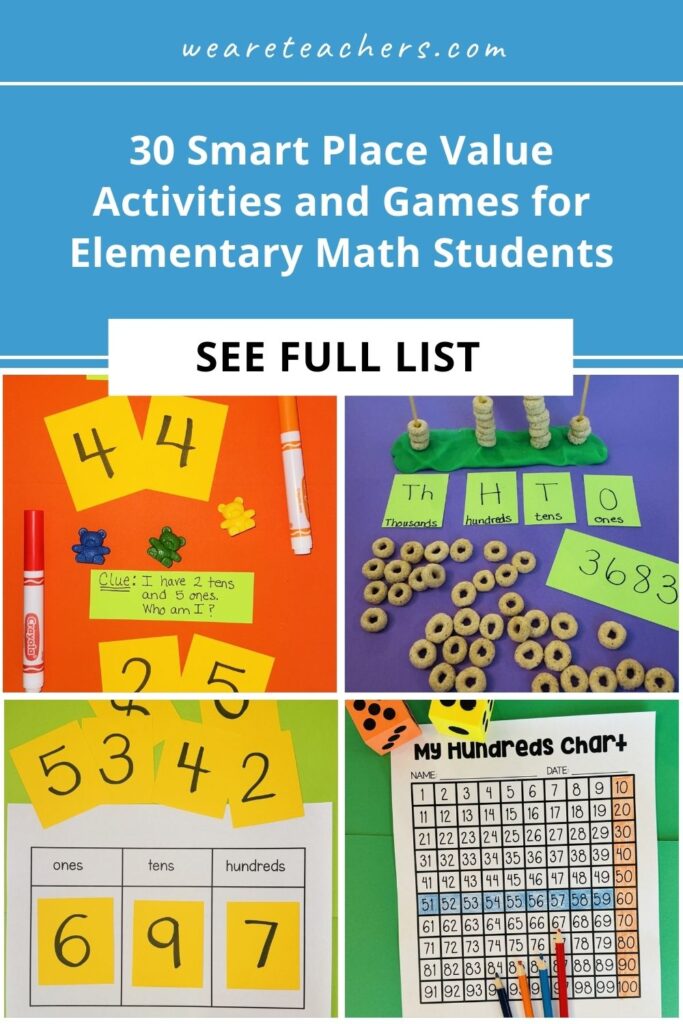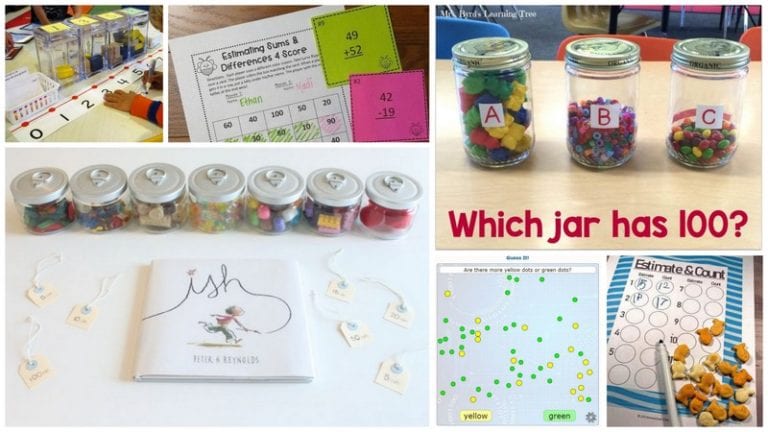I was in a curriculum meeting once where the speaker asked our group of teachers, “What is the most important thing you can teach a child?” I started thinking, maybe self-confidence or acceptance … when a colleague of mine, admittedly a total math nut, called out, “Place value!”
I laughed, but I got where she was coming from. If you’re going to understand our number system at all and everything based on it like addition, subtraction, multiplication, and so on, you have to understand place value first. It’s a brilliant concept where a numeral can change its value depending on where it is placed, hence place value.
Here are 30 fun, hands-on place value activities and games to help your students learn this all-important foundational concept.
1. Pick and Place
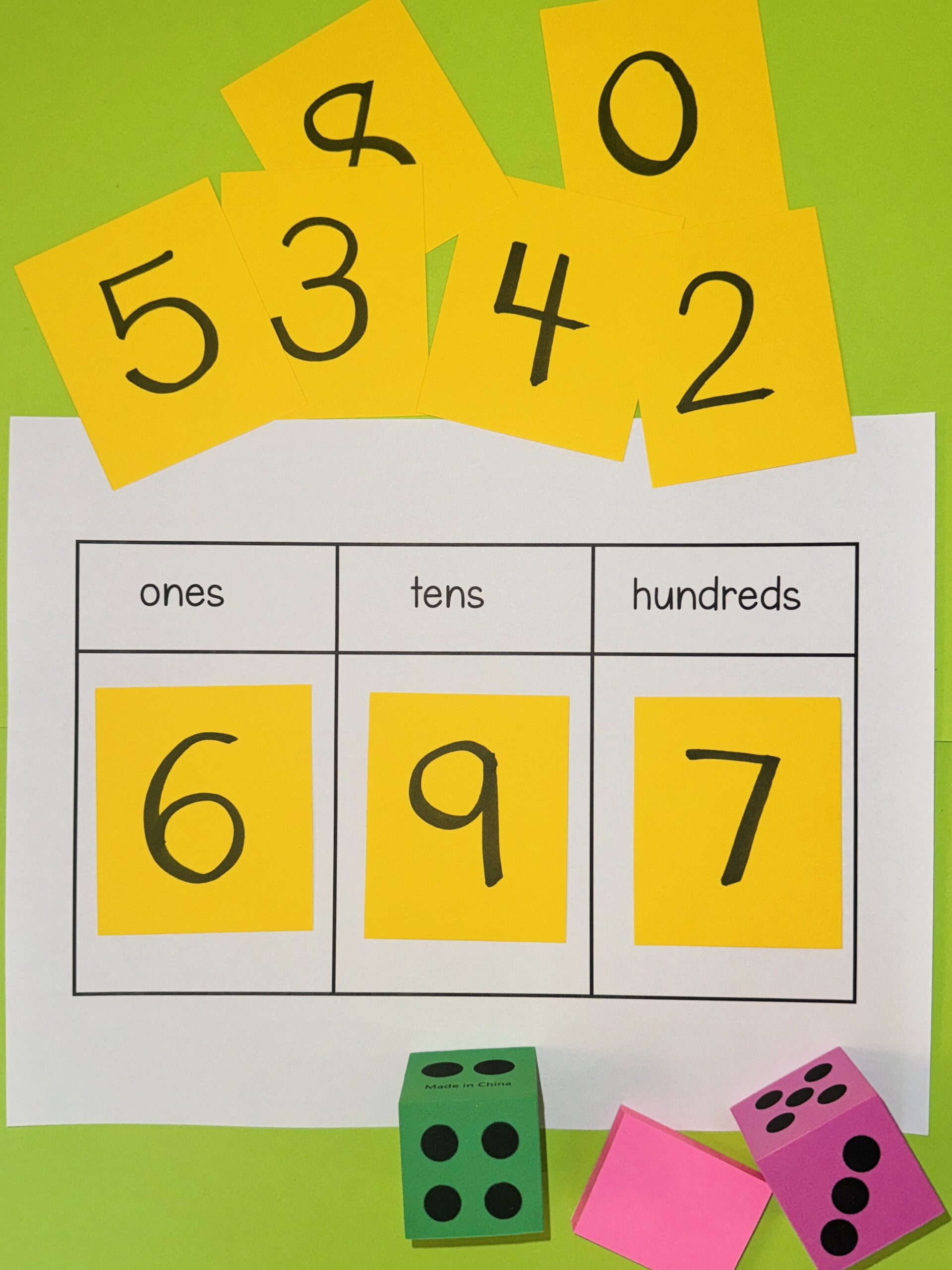
Using a pack of index cards, make a set of digit cards from 0 to 9, with two of each digit. Mix them up and put them in a stack. Prepare a simple chart with three boxes. The boxes are labeled ones, tens, hundreds. Make a copy for each student.
This is one of the place value activities that’s good to play with a partner. The object of the game is to create the largest number possible. Students take turns picking cards from the deck and placing them on their chart. When you pick a card, you must place it in one of those boxes. You can’t move it. Whoever has the largest number wins. You can play variations on this, such as trying to create the lowest number possible. You can also make the chart go as high as you like, adding boxes for thousands, ten-thousands, hundred-thousands, and higher to help meet the needs and level of your students.
2. Fiddle, Faddle, Flop
Begin by thinking of a two-digit number, like 25. Tell the class you want them to guess the number you are thinking of and that you will give them some clues after they make a guess. Let’s say the first guess from a student is 18. You would respond “Flop.” Flop means none of the digits in the guess is correct. A second student guesses 50. You would respond, “Fiddle.” Fiddle means one of the digits in the guess is correct, but it’s in the wrong place. (That would be the 5 in this example.) Now the class should realize there is a 5 in the number and it needs to be moved to another place, so the next student guesses 75. You would respond, “Faddle.” Faddle means one of the digits is correct and in the correct place.
It is good to make a chart or poster of these words and their “definitions” and have it visible during the game for students to refer to. Students listen carefully and record missed numbers and think about the place value of the guesses from the clues you’ve given them. You should record the missed numbers on the board as well. Keep playing until someone guesses correctly. Let students take turns leading the game and add place value places up to three digits, which becomes quite challenging.
3. Order in the Court!
Using index cards, have students create a set of number cards from 0 through 100. Have students partner up and put one deck in the middle. Ask them to shuffle the deck, and then each player deals three cards to themselves. Say “Go,” at which time players work together to try to put their six cards in order from lowest to highest on the desk. When they have them in order, they raise their hand and call out, “Order in the Court!” Have students read aloud the cards and their order to check for good understanding. First group done with all correct is the winner!
4. Money Matters
Provide each student with a set of play money with at least 10 dimes and 10 pennies. Just like in “Make It!” call out a number, only this time students use their coins to create the number. When you call out 52, we’re looking for students to put out 5 dimes and 2 pennies. Let students take turns calling out the numbers. Great practice for both place value activities and money practice, and it lets students experience how our money system is very place-value based.
5. Calculator Caller
A lot of place value is focused on how numbers are written. This activity provides students with practice in “writing” numbers with a calculator. Provide each child with a simple calculator. Have them freely explore with it for five minutes before you start. Then when it is time to begin, explain that you will call out a number. The students should then punch in that number on the calculator. Pick up the calculator and turn it to you so you can see the number they wrote. Give students a chance to lead the activity, and also partner students so they can “call” numbers to each other.
6. Change It Up
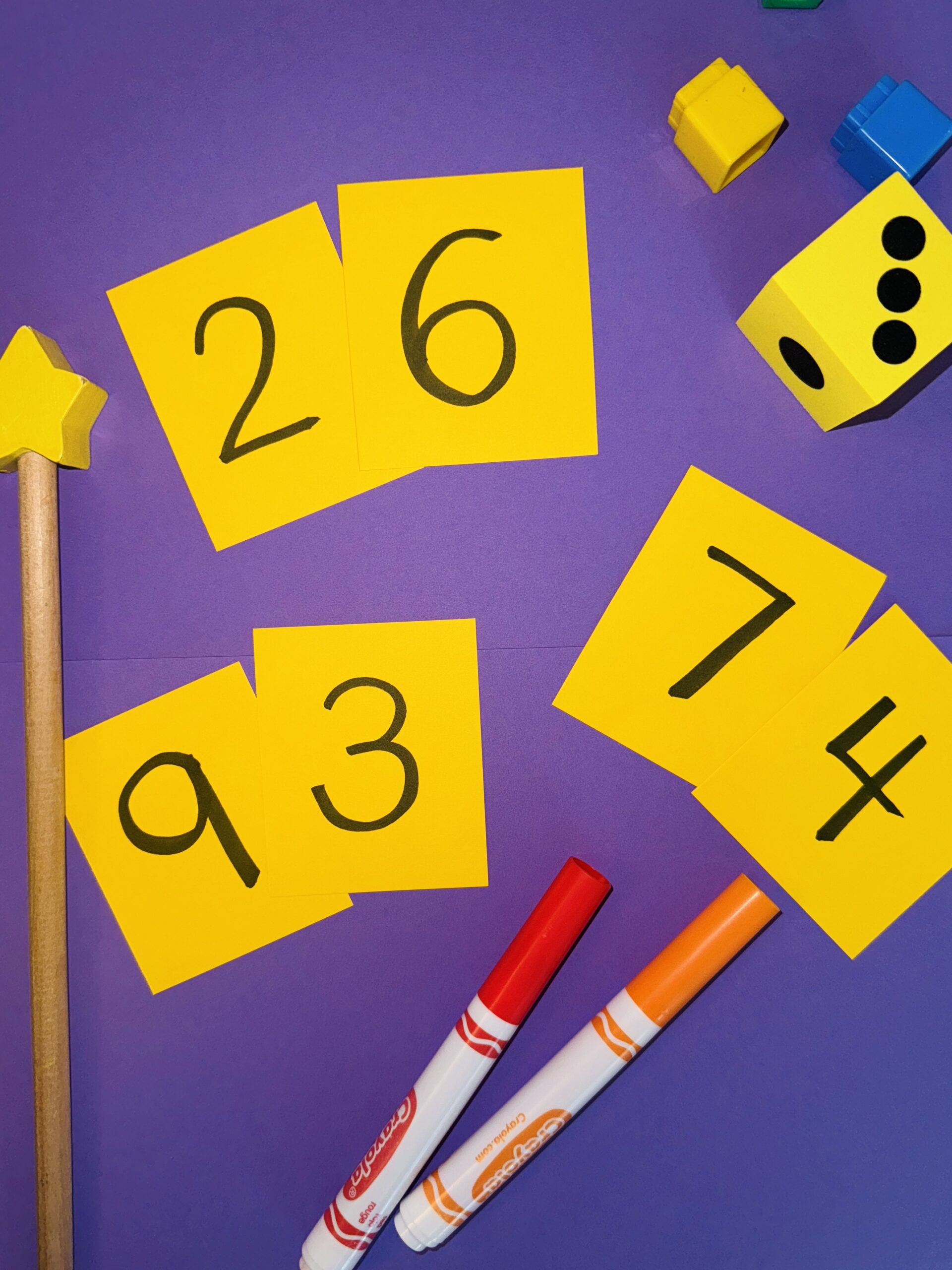
Give each student a set of cards with digits from 0 through 9. Each set should have two of each digit. (By the way, it is always even better if you give students blank index cards and have them make their own digit card set.) Call out a number and ask students to use their cards to make that number on their desks. For example, say, “84.” Students take their 8 and 4 cards and arrange them to show 84. Then say another number, like “48.” Students change it up by switching the places. Say, “78.” Now students have to go into their packs and get a 7 card and replace the 4 card with it.
Let students take turns calling out numbers. You can play this with as many digits as you like up into the hundred thousands, as long as you make enough cards. Kids love these place value activities!
7. Place Value Pieces Puzzles
There are at least four ways for a student to write a number, but you have to know some place value in order to do it accurately. To give students some practice with this, take a piece of card stock and divide it evenly into four sections. Label the sections “Standard Form,” “Place Value Block Form,” “Expanded Form,” and “Word Form.” Explain each form to students and create this model piece as they watch. If the number is 451, for Standard Form you can write the number “451” using digits. For Place Value Block Form, draw some simple place value blocks with 4 hundred flats, 5 ten sticks, and 1 one cube. For Expanded Form, write 400 + 50 + 1. And finally, for Word Form, write “four hundred fifty-one.”
Then model cutting the paper into four pieces. Explain these are now math puzzle parts. Invite students to do the same thing with a number you assign them. Provide card stock, markers, pencils, and scissors. After students are finished, you can mix these together and have students work as a team to sort them and put the puzzles back together.
8. Zero the Hero and the Amazing New Number System
Read aloud the book Zero the Hero by Joan Holub and Tom Lichtenheld. Give students whiteboards and markers. Ask them to see if they can write some numbers without using zero. First try 101. If you leave out zero, what have you written? Eleven. Try 90. What do you have without a zero? 9. Explain how zero holds a place so that the other digits can go where they belong.
Invite students to create a different symbol to substitute for zero. It might be a * or a @ or really anything. Have each student write three numbers using their new symbol for zero. Let them exchange papers with another student and see if they can read each other’s numbers.
9. Egg Carton Place Value Toss
Have students bring in empty egg cartons. The larger the better. Stand the lid up, and in the bottom of each area, tape a small cut piece of paper that says, in order, ones, tens, hundreds, thousands. Then give students nine dried beans. Have them move back 2 feet and, using an underhand toss, toss each bean into the box. When done, have them count up the beans in each place value area and determine the number they have scored. Write this down. Each partner takes a turn pitching beans into their boxes. Whoever scores the largest number in a round wins that round.
10. How Much Is That Building Worth?
Base-ten blocks are a great manipulative for learning place value concepts. After some practice with them, provide a small group of four or five students a class set to share. Explain to them that the task is for each student to use blocks to build a model of a building of their own design. As they build, however, they should keep track on a piece of paper the value of each block they use so that when they are done, they will know exactly how much their building is worth. For example if I build a model house using 8 hundred flats, 15 tens sticks, and 10 ones cubes, my building is worth 800 + 150 + 10 = 960. Have each student in the group record their values, then take a walk around looking at each other’s buildings and try to calculate the value of each one.
11. Place Value Riddles
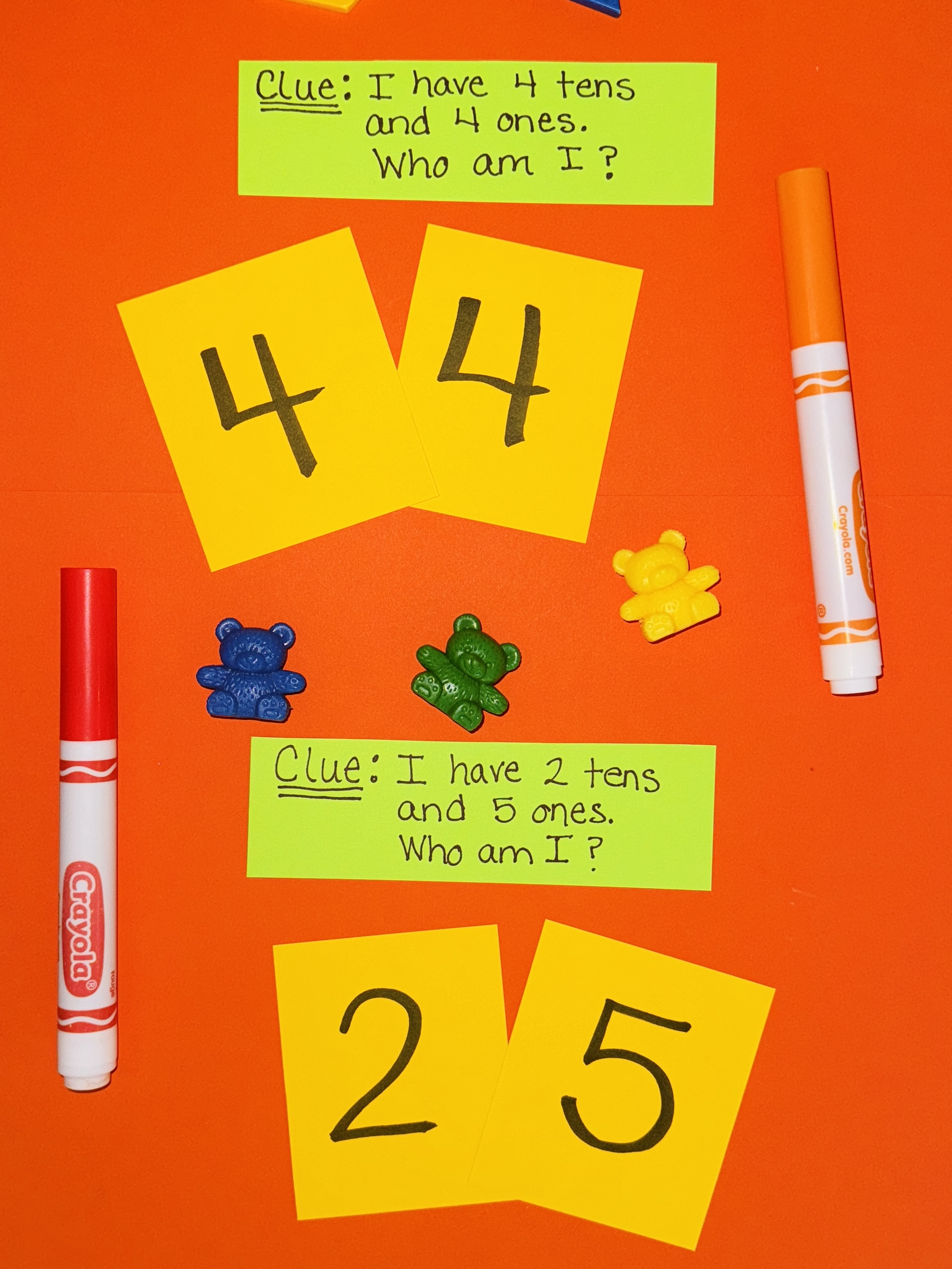
Have students use their digit cards for these place value activities as well. Give clues to a number you are thinking of and see if students can make the number on their desks with their cards. For example, “I have 4 tens and 4 ones. Who am I?” Students should make a 44 on their desk. You can do this with any number, no matter how high.
When students are ready for more challenging work, you can say something like, “I have 15 ones and 2 tens. Who am I?” Now students really have to think. Hmmm … 15 ones is a 10 and a 5, so I would move a ten to the tens place and have 3 tens and 5 ones, so it’s 35!
12. Newspaper Numbers
There are a lot of numbers in a newspaper. Gather students around and show them a newspaper and/or some advertising flyers. Flip through and stop when you find a number. Show it to students. Have them identify the number and explain what the number tells us. Give each student a newspaper, scissors, glue stick, pencil, and a piece of white drawing paper. Ask them to find some interesting numbers, cut them out, glue them on the paper, and write the number in word form. If there is time, have them also write about what the numbers tell us about.
13. Place Value Bracelets
Get a box of Froot Loops and pour it out onto a couple of lunch trays. Get three or four plastic bowls and ask students to help you sort the cereal into colors with red in one bowl, orange in another, and yellow in another. Explain that this will help prepare us for the activity.
Once the cereal is sorted, assign a value to each color. Red = ones. Orange = tens. Yellow = hundreds. Give each student a length of yarn or pipe cleaner that will fit around their wrists. Tell students that they will have a chance to build a place value bracelet. As they choose a Froot Loop for their bracelet, they should keep track of how much the value of the bracelet is. When they are done with their place value activities and tie off the ends of their bracelets, have them show you the bracelets and tell you the value. You check it for them and re-teach as needed.
14. “Who Am I?” Asked the Number
Give the class three place value clues and see if they can guess the number. For example, you might say, “I have 3 hundreds, 7 tens, and 2 more ones than I have tens. Who am I?” Students should be encouraged to keep notes on a piece of paper as you say the clues aloud. As they get an answer, have them share. After doing 10 of these, invite students to write one of their own with the clues on one side of an index card and the answer on the back. Collect these and use them over the next few days, giving credit to the author as you share each one.
15. One Hundreds Chart Patterns
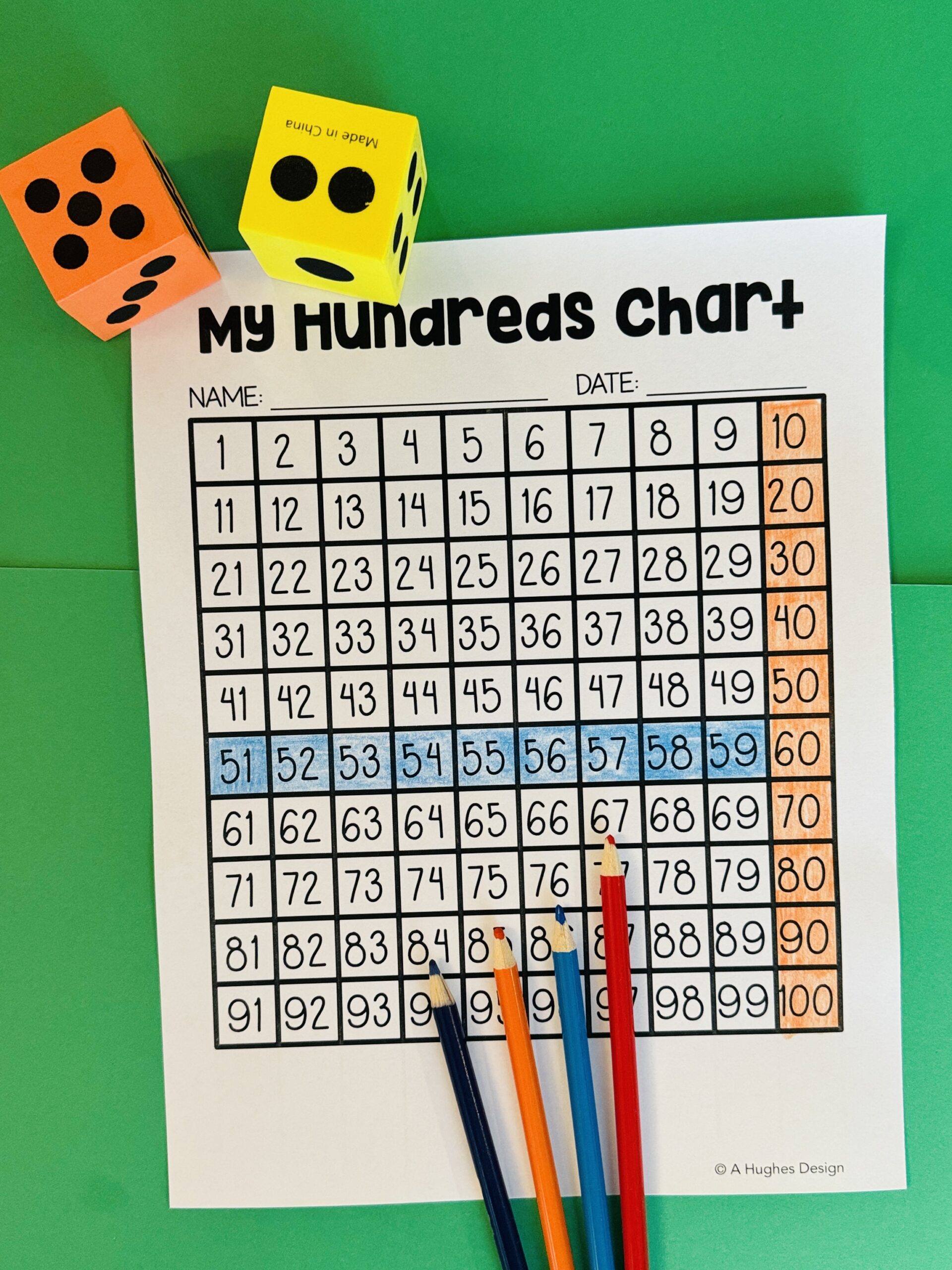
For these types of place value activities, provide each student with a copy of a one hundreds chart and a set of crayons or colored pencils. Give directions to have students color and locate certain numbers that would indicate a knowledge of place value. You might say, “Color all the numbers that have a 5 in the tens place blue,” and after that, “Color all the numbers that have a zero in the ones place orange.” As you do this, students will be made aware of the place value patterns that exist in our number system.
16. The Nuts and Bolts of Place Value
Buy some nuts and bolts from the hardware store to create some interesting place value models. Make sure the nuts fit on the bolts you buy. In fact, make sure you can fit 10 nuts on a bolt. Students can use these for any games or activities that require place value blocks. One of the interesting aspects of these is that when you put 10 nuts on the bolt and create a 10-bolt, those “ones nuts” never leave. They are still visible, but now bound together as a group of 10. As a starting activity, have students make target numbers you give them just to practice the fine motor mechanics of putting nuts on a bolt.
17. Hundreds Chart Place Value Path
Give each student a copy of a hundreds chart and a yellow or orange crayon or colored pencil. Explain to students that they are to begin with the number 1 and get down to 100. To get there, you will call out clues about some numbers. When they think they know the number, they should color it. All numbers must touch each other by a side or a corner. Tell students they must follow the path you provide the clues for so they can get to 100.
Give place value clues. From the 1, you might say something like, “I have the same digit in both the tens and ones place and I am touching you.” This would be an 11 and they should color that number. Do the first four together with explanations. Then just give clues. After everyone gets to 100 successfully, try the game again with new papers, only this time students take turns giving clues.
18. What’s Missing?
Write a two- or three-digit number on the board. Have students read the number aloud. Ask students to close their eyes. Erase a digit. Have students open their eyes. Ask students what’s missing. They must tell you in place value language. So if you wrote 589 and you erased the 8, all they see is 5 _9, but they can’t just say 8, they have to say either “80” or “8 tens.” Do nine or ten of these with you leading for practice. Then have students take over as the game leaders.
19. Make That Number!
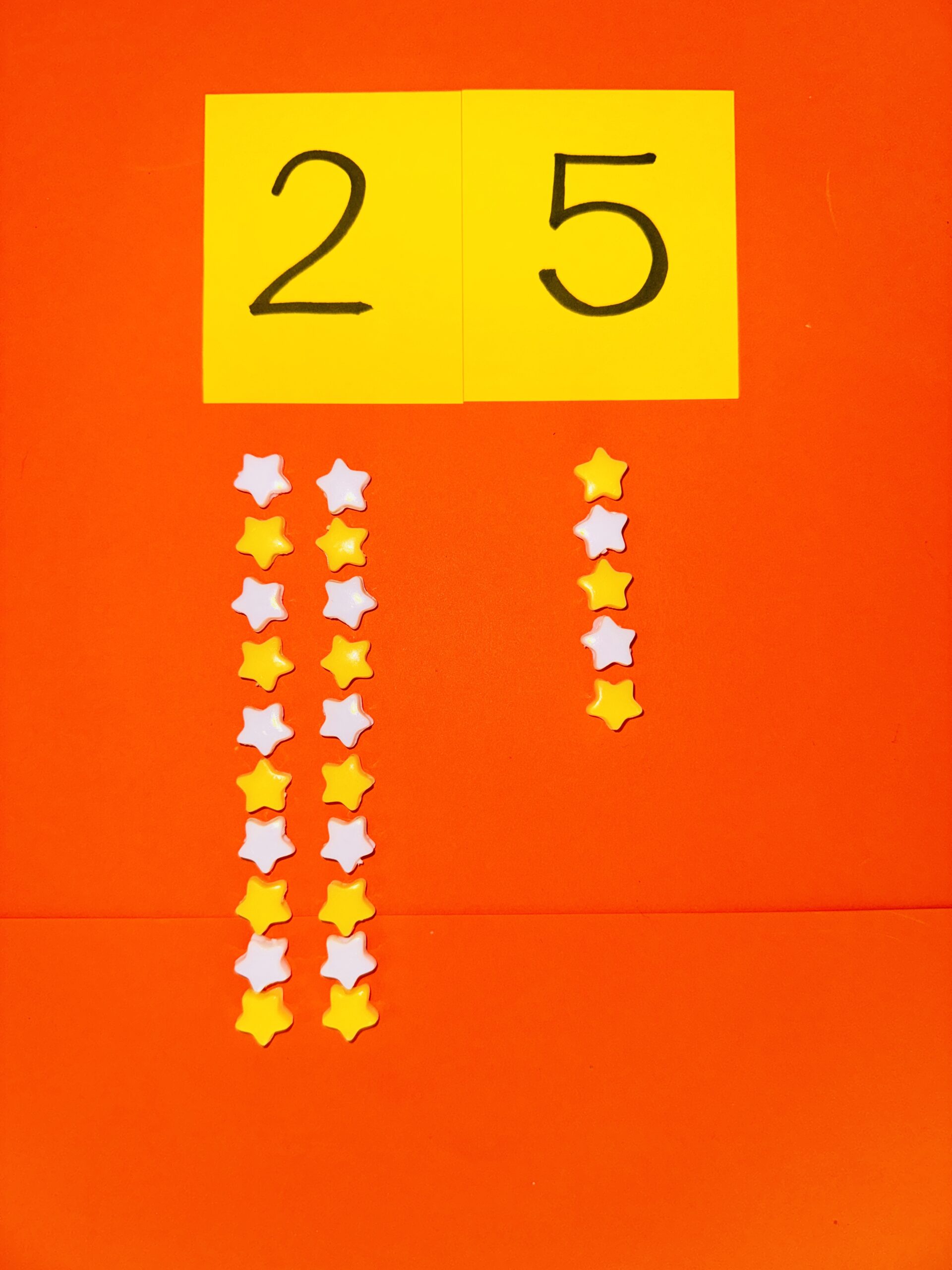
Kids like to get their hands on things and move them around. Here’s a good way to do that and practice place value.
Provide each student with a group of small manipulatives such as cubes, counters, beads, or even dried beans (very cheap and they work well!). Call out a number and ask students to count out that many of their objects. Then ask them to arrange the objects into groups of tens and ones. There are lots of ways to do this for a student. If you call out 25, they might show two rows of 10 and a small group of 5, or two circles of 10 and a smaller circle of 5. The arrangement can vary creatively as long as it is understandable.
20. Find It!
Provide students with whiteboards, markers, and erasers. Write about a dozen numbers on the board and ask students to copy them onto their whiteboards. The numbers should be varied, including one-digit, two-digit, and three-digit numbers as well as trying to use all the digits 0 through 9 somewhere in the group. Now give place value clues to your students to identify a specific number. When they find it, they circle it and raise their hand to tell you the number and why they circled it. For example, let’s say your list of 12 numbers consists of 7, 13, 25, 100, 66, 222, 48, 49, 115, 30, 2, and 82. You could give directions such as “Find the number that: a. Has a zero in the tens place. B. Has three tens. C. Has five ones. D. Has three digits and is more than 101. E. Is in the 60s” and so on. Once all numbers are found, erase the boards and begin again with new numbers. Kids can supply numbers and clues as well.
21. Roll and Compare
This is simple but fun. Give students three number cubes, graph paper, and a pencil. At the front of the room, roll one number cube. Announce the number and write it on the board. Ask students to write the number on their papers. Now have students roll one of their cubes and write their number directly under your number. Digits should be lined up with each digit in its own box on the graph paper. Compare and circle the larger number.
Continue to roll a few one-digit numbers, then move to two-digit numbers (the first cube you roll is the tens and the second cube is the ones), and finally three-digit numbers. Students continue to roll, write, and compare. Sometimes numbers they roll will be the same as your number. Have students put a star next to those.
At the end of the sessions in these place value activities, ask students questions like, “What was your highest roll? Lowest roll? Did any numbers end up being the same as the target numbers?”
22. Place Value Boxes
Bring in three small boxes, like tissue boxes. Label them ones, tens, and hundreds. You can always go higher with more boxes if you like. Take a set of digit cards and distribute them into the three boxes. Have a student come up and pick a card from each box. They then take their three cards and arrange them to create the largest number possible and then the smallest number they can. Have students put these on the carpet so the whole class can see the numbers created and identify the largest, smallest, odd numbers, even numbers, and so on.
23. Race to 200
Have students form partner teams in this place value activity and give each team a set of place value blocks. Players take turns rolling dice and taking that amount of cubes from the set. As they get 10 blocks, they trade in for a ten rod. After they have 10 ten rods, they trade that for a hundred flat. Keep rolling, trading, and playing till someone gets 200!
24. Color Code Place Value Line Design
Here’s a way to get artistic with your place value work. Give each student a box of crayons, white drawing paper, and a pencil. Have students pick three different-colored crayons. In the lower right-hand corner of the paper, ask them to create a place value color key assigning each color a value. For example, blue = ones, green = tens, and red = hundreds. Now they should create a design made up of lines using these three colors. As they work, they should keep track of each line they draw so when they are done, they know the total value of their design. They then write the number as the title of the work on the top of the paper. This makes a great bulletin board!
25. Place Value Cover-Up
Have students partner up. Each partner gets a piece of drawing paper and writes down three numbers, all two-digit, three-digit, or four-digit. Underneath the numbers, they write the number in word form. Taking checkers or counting chips, players cover up one digit in each number. They then ask their partner to guess what digit is covered up. If they guess right, they win the chip. Switch places. Continue play for five rounds, then count up the chips. Most chips wins. Hint: Placing a zero in a number somewhere always makes this more challenging.
26. Cheerio Tower = Place Value Power
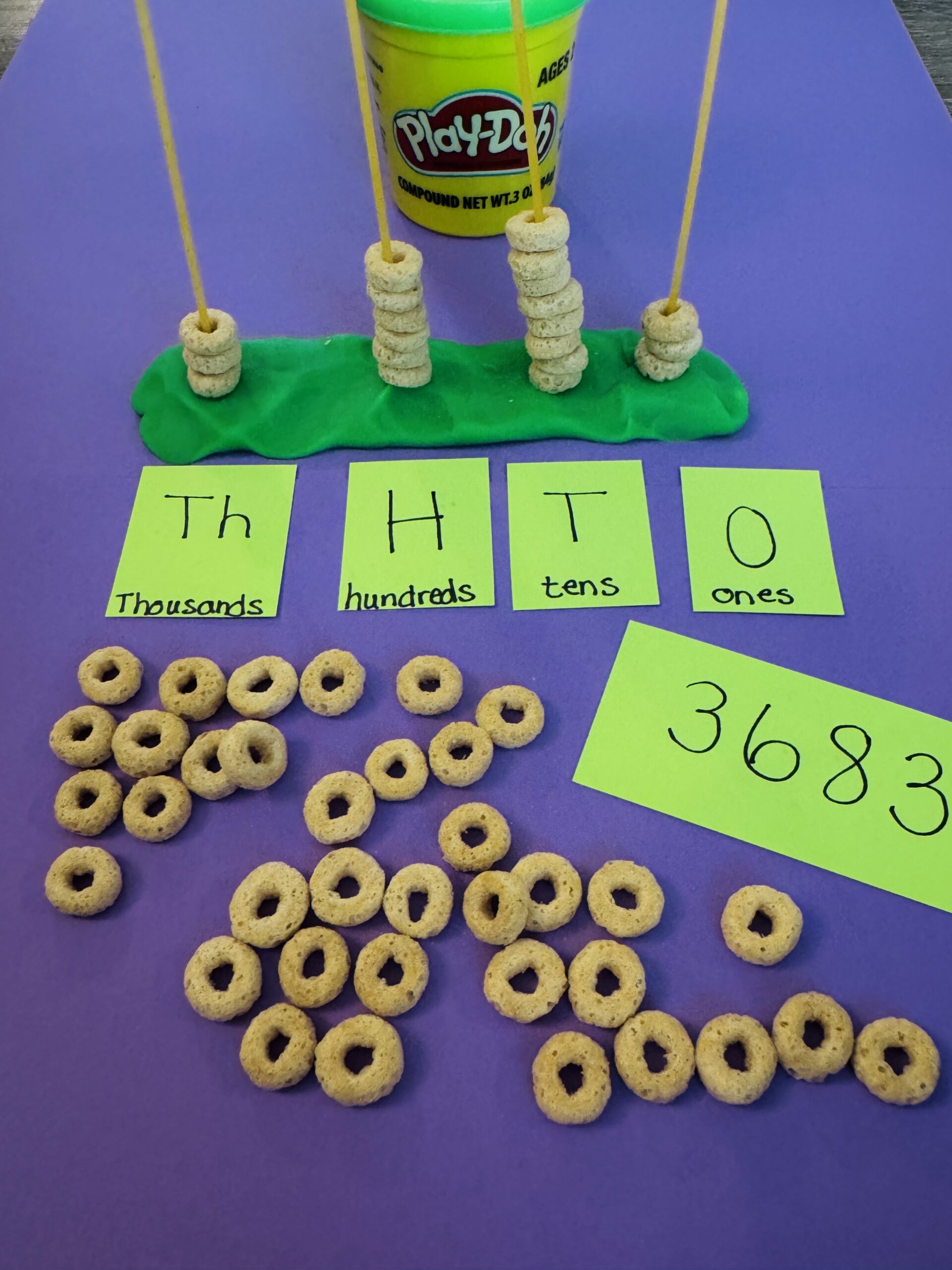
Place value activities that involve snacks are always a hit with kids. For this one, provide each student with a small ball of clay, four strands of uncooked spaghetti, a handful of Cheerios, and a small piece of card stock. Model for students how using these items, they can build a Cheerio Place Value Power Tower. Flatten the clay out and with some space in between, put the three pieces of spaghetti into the clay so they stand up. Next take the card stock and cut it into three or four small pieces and mark them as follows: O for ones, T for tens, H for hundreds, and Th for thousands. Place the card stock signs into the clay in front of each “tower.” Now call out some numbers and have students use their Cheerios and towers to model the number. For example, if the number is 325, there should be 3 Cheerios on the H tower, 2 on the T tower, and 5 on the O tower. This is a simple but fun place value model kids will want to use again and again.
27. Place Value Spin to Win
Partner students up. Give each pair a simple spinner with digits 0 through 9 on it. You can make this with a circle cut from card stock. Divide the circle with a rule into nine sections. Place a pencil and a paper clip in the middle and you’re ready to flick the paper clip and spin a number. Each partner team has six index cards. Have them write “ones” on two cards, “tens” on two cards, and “hundreds” on two cards. Lay them face down, shuffle, and create a small deck.
Have each student take out a pencil and lined paper along with their spinner. The lead player spins a number. Let’s say it’s a 7. The second player picks a card. Let’s say it’s a “tens” card. That is the lead player’s first number. They write that down in the tens place. The lead player spins again. Their partner picks a card. This continues three times, at which point the lead player now has a three-digit number. That’s their score. Players switch roles. Whoever ends up with the largest number wins.
28. Compare 11
Understanding how to compare numbers is based on an understanding of number and place value. Give each student a pack of index cards. Have them write 50 different numbers on the cards. You can assign parameters for what numbers you want them to use based on ability and age level.
Students partner up, each with their own deck. They shuffle decks and lay them face down. Then they each simultaneously pull a card from their decks and flip it over to reveal the number. They line cards up one above the other and compare. Whoever has the higher number wins a point for that round. Put cards in a discard pile and continue for 11 rounds. Whoever has the most points wins.
29. What Is Your Name Worth?
Provide students with a set of place value blocks. Use only tens sticks and ones cubes. Have students take their blocks and spell out their first names on their desk. Then have them add up the blocks to find out how many cubes it took to build their names. The best way to do this is gather all the ten sticks, add them together, then gather all the ones blocks and add them together. Finally, add the tens and ones and see what the total value of the name is.
As an extension, ask students to try to build their names with fewer blocks, then compare the values.
30. 100 Exactly!
Give students a set of base-ten blocks. You will only need tens sticks and ones cubes. Ask students to build something that has a value of exactly 100 blocks on their desks. It could be flat or standing up. It could be a building or a car or a name or a design, whatever they like. As you go around and visit the designs, ask students their strategies for using exactly 100 blocks. Share strategies in discussion and then create a new design.
Looking for even more math activities? Try these fun and free fraction games!
Plus, sign up for our newsletters to get all the latest teaching tips and ideas, straight to your inbox.
